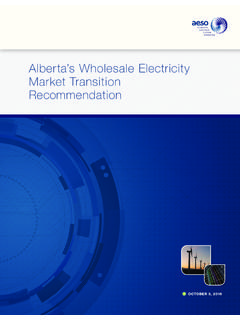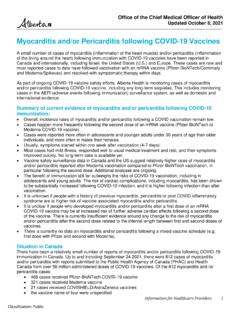Transcription of COVID-19 - Pandemic to Endemic
1 COVID-19 INFORMATION SHIFTING FROM Pandemic TO Endemic 2021 Government of Alberta | Published: September 2, 2021 Classification: Public Introduction Over the past year and a half we have faced an extraordinary threat together. COVID-19 has required unprecedented measures that have saved lives and prevented our health care system from being overwhelmed. Unfortunately, these measures also came with harms, and now having highly effective, widely available vaccines means we need to continually reassess the balance of direct harms of COVID-19 against the indirect harms of measures to prevent its spread at a population level. We will not eliminate COVID-19 , which means we need to learn how to live with it. This is why we have begun to shift our COVID-19 approach towards an enhanced version of the solid foundation of our systems to manage other respiratory viruses.
2 Some changes have already come into effect and we anticipate moving forward with the remainder on September 27, provided the evidence, data and further monitoring confirm original expectations. If monitoring of the data warrants a change to recommendations, that will, as always, be considered. Here is some of the information public health experts looked at to initially make these decisions, compared with our current situation, to explain why we have temporarily delayed some measures. Broader Impacts of COVID-19 The extraordinary measures put in place to manage COVID-19 have had direct and indirect individual and societal impacts. For example, there has been a significant shift in health human resources to respond to COVID-19 , which has meant less ability to focus on other health priorities.
3 The measures themselves have also had direct and indirect impacts on Albertans mental health. We will not fully understand many of the impacts for months or even years to come. In considering the timing of the shift towards living with COVID-19 , the evidence and data that informed our recommendations included the continued social, mental and other societal impacts of extending the extraordinary measures above all other critical health needs. Ongoing deployment of health care personnel to large scale COVID-19 interventions limits the ability to redeploy staff to other areas of need that fall further and further behind. Mental Health and Social Isolation Measures needed to manage COVID-19 transmission have had impacts on our population s mental health and wellbeing.
4 Social isolation measures have worsened mental health in those already most at risk while also limiting access to ,ii,iii In particular, mental health in children has been impacted by isolation linked to loss of social interactions, made even worse when economic stress is present in their In Alberta in 2020, hospital admissions for anxiety for children between the ages of 5 and 18 were 19% higher than the previous five year A final example comes from the HQCAvi report from the fall of 2020, reporting that: over half of those surveyed reported not staying as socially connected as they were before the Pandemic , almost one third of participants indicated that they had delayed seeking health care during the Pandemic , and nearly 70% of participants reported feeling more stressed out during the Pandemic with factors including difficulty maintaining relationships, difficulty sleeping, inability to exercise and loneliness.
5 Cancer Screening Rates Cancer screening rates around the world have been reported to have been impacted by COVID-19 In Alberta, from March to December of 2020, 189,500 women received a pap test, compared to 257,800 the previous year, a drop of 26%.viii Similarly, the number of women receiving a mammogram declined 25%.ix Early detection is key to the early treatment of cancer, which is dependent on cancer screening. To increase screening and catch up with the gap, time and human resources are needed. Childhood Immunization Rates During the COVID-19 Pandemic , there has been a reduction in childhood immunizations across Canada as people kept their children home to adhere to COVID-19 restrictions and school-based immunization programs were interrupted.
6 For example, in 2019, 73% of 12 year olds in Alberta were fully immunized for Hepatitis B. This dropped to just 28% in Catching up with routine childhood immunizations is a key priority for protecting children. Syphilis In 2019, Alberta declared a province-wide outbreak of syphilis, with 2,265 reported cases and syphilis rates at levels not seen since 1948. Untreated syphilis can cause blindness, paralysis, deafness, brain and heart disease, and mental health problems. Untreated syphilis in pregnancy can cause congenital syphilis in babies, leading to late-term miscarriage, birth defects and stillbirth. There were 2,509 infectious syphilis cases in 2020ix COVID-19 INFORMATION SHIFTING FROM Pandemic TO Endemic 2021 Government of Alberta | Published: September 2, 2021 Classification: Public There were 55 congenital syphilis cases in 2020 (compared to 25 in 2019)x As of August 17, there had been 1,655 infectious syphilis cases and 29 congenital syphilis cases (5 stillborn) so far in 2021x Opioid Deaths Alberta, like many jurisdictions, has seen deaths as a result of opioid overdose increase significantly when compared to pre- Pandemic rates.
7 There has been a monthly average of 109 deaths due to opioid overdose from March 2020 to May 2021 compared with a monthly average of 50 deaths in the 12 months prior to March EMS Response Rates to overdose-related events have also increased significantly when compared to pre- Pandemic rates. Provincial EMS responses rate to opioid related events were xii: per 100,000 in 2019 per 100,000 in 2020 Surgical Backlogs Surgeries delayed/postponed due to the Pandemic have resulted in a total COVID-19 backlog of approximately 40,000 procedures. Significant progress has been made to address the backlog, with nearly all of the COVID-19 delayed/postponed surgeries now rebooked. However, this has required a substantial focus of resources, with the province exceeding 100% of pre- COVID-19 surgical capacity to address this deficit.
8 COVID-19 Immunization Impact Vaccines are a game-changer with COVID-19 . We have the advantage of having wide access to highly effective vaccines that provide significant protection against infection and even greater protection against severe outcomes. While no intervention is perfect, Alberta data shows that, similar to results in other jurisdictions, two doses of vaccine are 85% effective against infection from the highly infectious Delta variant, and are even more effective against other While there is still work to do to ensure all barriers to vaccine access are minimized, vaccine uptake in Alberta has been higher than most US states, and more similar to the UK earlier this year. Therefore, looking at population comparisons of the impact of the Delta variant should take this specifically into account.
9 At the peak of their Delta surge in late July, the UK had of their total population fully immunized. In Alberta, as of August 18, we have This is not enough to keep COVID-19 from circulating in the province, and individuals, particularly those in older age groups who do not have vaccine protection, are still at risk of severe outcomes. However, at a population level, the risk of overwhelming the health care system has been greatly reduced by vaccines. At the time of making a recommendation in early July, data from the UK was used to inform what we could expect to happen in Alberta. Countries such as the UK, with very high vaccination rates, are generally seeing much lower rates of hospitalizations and incidence of critical illness despite high case numbers.
10 Residual Sample Serosurvey When considering the impacts of case detection from widely available PCR testing and contact tracing, we looked at data from monthly blood sample antibody tests done over the course of the These showed our PCR testing program detected only about 1 of every 4 cases when compared with antibody testing (when taking waning antibody levels into account). This is due in large part to the fact that not everyone goes for testing when ill or mildly symptomatic. More recent data supports this estimate showing that, as of the July 2021 serology sample, only 26% of those with antibody evidence of past infection had a previous positive PCR Because we will have early transmission trend information available with expanded wastewater surveillance going forward, widespread PCR testing of mild cases of illness won t be needed to give early warning signs of increased virus levels in communities.










